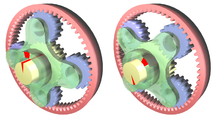Transmission
In mechanics, a transmission or gearbox means gears working together. The most common transmission is the transmission in a car.

In a car, the engine makes the crankshaft spin. The crankshaft makes the transmission's gears spin, which spin some more parts, which make the wheels spin. But the wheels do not spin as fast as the engine makes the crankshaft spin. That is because the gears are made to slow down the spinning. The gears also give the spinning more force (or to be more scientifically exact, more torque), so the wheels can make the entire car move. Most transmissions have a breather vent to let hot air escape.[1]
Transmission gears
changeA transmission has some gears that change the torque more than other gears. That is why a transmission has a first gear, second gear, third gear, and sometimes more gears. There is also a reverse gear and neutral. An automatic transmission shifts between gears by itself (except reverse gear, and a parking gear). A manual transmission needs the driver to decide when to shift gears. Manual transmission is also called standard transmission. This is confusing because almost all cars in the U.S. have automatic transmission. In other words, since the late 20th century "standard" transmission has been unusual. A manual transmission usually has a clutch pedal, which the driver must press while shifting gears. An automatic transmission has a fluid coupling called a torque converter instead of a clutch. Some cars have a "clutchless" manual (semi-automatic) transmission, which has an automatic clutch (no clutch pedal), but does not shift gears by itself.
Layshaft
changeA layshaft is the middle shaft within a gearbox (transmission). When the clutch is engaged, the layshaft turns constantly.[2] All gears on the layshaft turn at the same rate and are permanently attached.[2] It carries gears but does not transfer the primary drive of the gearbox in of the gearbox or out of the gearbox.[3][4] Layshafts are mostly known through their use in car gearboxes.[5] The oil level in a gearbox is set to layshaft height. That way the spinning gears distribute oil to all the gears.[6]
Other types
changeNot all transmissions are in cars. For example, bicycles have transmissions. You can see the gears, so it is easier to see how it works.
References
change- ↑ Ron Sessions, The Turbo Hydra-Matic 350 Handbook (Tucson, AZ: HPBooks, 1985), p. 96
- ↑ 2.0 2.1 "The Transmission Bible". Car Bibles. Archived from the original on 4 March 2012. Retrieved 28 November 2015.
- ↑ Setright, L. J. K. (1976). "Gearbox". In Ian Ward (ed.). Anatomy of the Motor Car. Orbis. p. 88. ISBN 0-85613-230-6.
- ↑ The Autocar (c. 1935). Autocar Handbook (Thirteenth ed.). London: Iliffe & Sons.
- ↑ "Car manual". www.manualload.com. Archived from the original on 5 March 2016. Retrieved 24 October 2015.
- ↑ Victor Albert Walter Hillier; Peter Coombes, Hillier's Fundamentals of Motor Vehicle Technology, Book 1 (Cheltenham: Nelson Thornes, 2004), p. 283